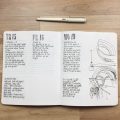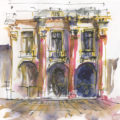
It’s always good to spend a bit of time thinking about a project after it is finished and this is particularly the case for my 30×30. As I have been travelling for the whole month of June, I’ve been more occupied with new places and time with family/friends, so I haven’t really been thinking much about the actual challenge. Therefore the discipline of writing this article is forcing me to review all my work from June and pull out some of the ideas that have been floating in the background as I travel.
Perhaps the biggest surprise from this challenge has been how much a much easier it was than I expected. For the first half I had to be very intentional about doing a paint only sketch, but in the second half of the month it came easily without trying. I think this is mainly circumstantial rather than the result of an improvement in my skills! For the last two weeks I was in Scotland doing landscapes (a subject which I mainly do in direct watercolour) and then I had a week dedicated to sketching in Krakow with my friend Esther Semmens.
But if I had to condense my all 30×30 thoughts from the past four weeks I would have three main takeaways.
Note: these takeaways refer to my approach to direct watercolour (note: paint only is my term) which involves doing as much as possible in one pass with lots of white space, and this is very different from Marc’s approach of layering washes. I often draw with the brush and only do minimal washes of big shapes. The exception is my landscape work which at the moment seems to have a few passes.
1. Subject Matter
- There are definitely some subjects which are easier to sketch in paint-only – isolated objects (tea cups and coffees), details, and more natural scenes (landscapes, trees, seascapes etc.).
- When tackling a complex scene, the trick seems to be to radically simplify it into a few edges and shapes. This makes it much easier for me to only use paint.
- The range of colours – I generally choose subjects with simple colour for my direct watercolour work as there is less danger of washes merging in undesirable ways when working quickly. This leads onto the next takeaway…
2. Time
- I found that my paint-only sketches were either much quicker than my normal approach to ink and wash (which isn’t really traditional ink and wash anyway) or much slower.
- The quicker paint-only sketches are (not surprisingly) those of simpler subject matter – either the simple objects or when I have been very selective as to what I am recording.
- But more complex subjects took more time, purely because I had to wait for the first pass to dry before adding crisper painted details of the top. This tightening up of the first pass (sometimes loose washes) with hard edges is much easier and quicker to do with a pen. This leads onto the next takeaway…
3. The decisive moment
- At the halfway mark, I mentioned how it was hard at times to not reach for my pen. However I found that in the second half of the month, if I simply resisted that first urge to switch to pen, I was comfortable to continue in paint. So this is the decisive moment! (Reminder: my normal way of sketching these days is to start with paint and then switch to pen after a few initial washes/edges are defined with paint, so starting with paint is nothing new for me. It was the continuing with paint that was needed to met the quota.)
- I also discovered that the inaccuracy of my first shapes was often the reason why I wanted to start drawing with my pen (ie. to correct it) so the solution wass just to ignore the ‘wonky’ thoughts and keep going. Sketching alongside Esther last week made me realise this, as a number of times she commented ‘that looks good’ right at the moment I was thinking ‘Aagh, it’s so out of whack”. She didn’t realise the inaccuracy but just saw the strong shapes. (Hmm, that leads on to another thought… but I’m going to stop at three takeaways!)
I haven’t really mentioned the fact that this challenge was great for focusing on shapes rather than edges mainly because I didn’t feel any real shift in my visual thinking. Is this a sign that I do think in shapes a lot? (I hope so!)
I also didn’t mention how working with direct watercolour helps to improve the control of water and pigment in each wash. This is so important and something which I spend a whole lesson on in my SketchingNow Watercolour course (which will be returning in Sept – more here).

Oh! there is a lot more that I write about… and I haven’t even shared my additional 11 paint-only sketches which I did last week in Krakow – another post, hey?
All in all it was a fantastic challenge, and I want to do it again when I get home. Travelling all June made it too easy for me, and I like to be stretched more.
Thanks Marc Taro Holmes for creating such a wonderful challenge! It certainly brought me a lot of clarity as to how and when to use direct watercolour so that I can do it more often.
So how did you go? I would love to hear your thoughts.










2 Comments
I’m up to about 25 so far, I started before June 1….and will finish after June 30…but that’s ok 🙂 I have really enjoyed working in watercolour only, and getting better at it. We all know that practice is the key…but it still is always a surprise to see it unfolding in concerted challenges like this 🙂
At the start of the challenge I felt my sketches looked unfinished and not refined enough. Now I think two things have happened – partly I have adjusted my technique, and partly I have come to appreciate this look more. I am using ink now only when I don’t have time or am not in the right place to get watercolours out, and then I can sketch in pen and add washes later e.g. yesterday at an all-day workshop for work I wasn’t comfortable to start paining (!) but ‘doodling’ a sketch to paint later was ok. Thanks for this encouragement to reflect back over the challenge.
Thanks for sharing Victoria – I remember when I also didn’t really like the look of watercolour only sketches – I was so in love with ink lines that it looked incomplete without them. Well done for hitting 25!
NEWSLETTER
Subscribe for first notification of workshop + online classes and more.